Select image to enlarge and view caption.
Corn Belt Region
What makes this region unique
The unique characteristics of the Corn Belt Region shape the fish and wildlife that inhabit it. If you travel here, you’ll find landscape scraped flat by a past glacier. Along with leveling the land, the glacier also left behind fertile soils that once supported an expansive forest that now serves as valuable agricultural land.
Surprisingly, you’ll find that various unique habitats coexist in the Corn Belt, the largest natural region in the state. While the northeastern portion of the region contains swamps, the western part contains areas with rocky canyons found nowhere else in Indiana. If you visit in spring or fall when the agricultural fields flood after a rain, you may see greater yellowlegs foraging during migration. In pockets of wetlands like small creeks, ponds, or lakes, you might hear what sounds like marbles clinking together but is the Blanchard’s cricket frog’s call.
Most of the remaining forests are flatwoods, where trees grow on relatively flat terrain, and the soil holds water in the spring. There, you could encounter a slow-moving terrestrial Eastern box turtle, a species that lives near thickets, pastures, marshes, and bogs. In the northern part of the Corn Belt, where the soils are drier, you might observe the white-striped American badger lumbering near agricultural fields or open, grassy areas.
The region is also unique in that it is home to fish and wildlife that thrive in its remaining wild places.
State wildlife action planning in the Corn Belt region
In December 2023, partners from the Corn Belt region convened to discuss the ecosystems that are in need of conservation in the region. Then, conservation strategies were built around the most pressing threats to these ecosystems. In 2024, we’ll be working with partners to further refine elements of the regional plan. Partners who have not been involved in the work are welcome to participate in the refinement process.
Curious about who has been involved in the process? Check out our list of partners below.
- Thank you, partners!
- Acres Land Trust
- Ball State University
- Cass County SWCD
- Central Indiana Land Trust
- Central Indiana Trout Unlimited
- Environmental Education Association of Indiana
- Fort Wayne Zoo
- Franklin College
- Grace College
- Groundwork Indy
- Hoosier Environmental Council
- Indiana Association of Soil and Water Conservation Districts
- Indiana Conservation Voters
- Indiana Department of Environmental Management
- Indiana FSA
- Indiana Land Protection Alliance
- Indiana Native Plant Society
- Indiana State Trappers Association
- Indiana University
- Indiana Wildlife Federation
- Keep Indianapolis Beautiful
- Little Rivers Wetland Project
- Lochmuller Group
- Merry Lea Environmental Center
- Morgan County SWCD
- Muncie Sanitary District
- Natural Resources Conservation Service
- NICHES
- Pheasants Forever / Quail Forever
- Purdue Extension
- Red-tail Land Conservancy
- SARE / Purdue Extension
- Sierra Club
- Stantec
- State of Indiana Cooperative Invasive Species Management
- The Nature Conservancy
- Tippecanoe Parks and Recreation Department
- University of Indianapolis
- Wildergarden
- Wolf Park
- Xerces Society
- Zionsville Parks and Recreation Department
Interested in learning more about the progress of the Corn Belt regional plan? Contact Elizabeth Mabee (SWAP@dnr.IN.gov; 463-203-3095).
Conservation at work
- Eel River Dam removal: Helping fish, mussels and people
While dams were originally built to turn water wheels at grist mills or produce electricity, they also prevent fish from moving up or downstream. Aquatic biologist Rod Edgell worked with Logansport Utilities, U.S. Fish and Wildlife Service, and Ecosystems Connection Institute to remove the last remaining barrier to fish migration on Eel River. Low-head dams like the one on the Eel can also harm people by generating an undertow that traps swimmers and boaters in the water.
After the dam was removed and the Eel was reconnected with the Wabash River, the fish community shifted, migrating into the restored stretch of the Eel that was no longer impounded. Biologists even began to find previously undetected species in the Eel and will watch for changes in mussels listed as Species of Greatest Conservation Need. Although some people prefer to see dams stay in place, Edgell says that dam removals are one of the most important river restoration projects we can complete because the removals help paddlers enjoy the river and support aquatic life. “The fish respond to the changes as fast as the river changes,” Edgell says. “Mother Nature takes care of itself.”
Learn more about the Lake and River Enhancement (LARE) program.
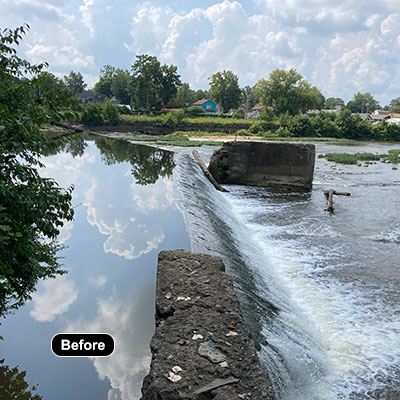
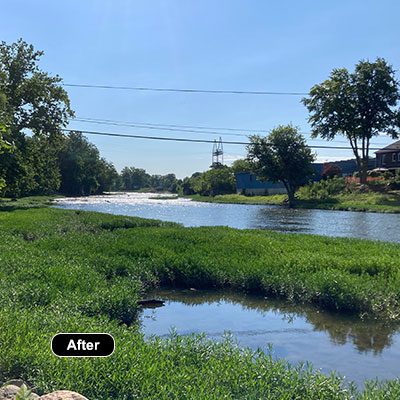
- Parke County private land re-wilding benefits wildlife, water, and soil health
Parke County sits in the Corn Belt Region of Indiana and provides various opportunities for conservation. Wildlife biologist Mike Mycroft worked with an area landowner who wanted to create a shared space for hunting and conservation on their property. After partnering with the Natural Resources Conservation Services and Indiana Department of Agriculture, Mycroft helped the landowner convert some of the agricultural area into pollinator plantings, food plots, and shrubs, including an area that had severe erosion along a creek bend. Through this re-wilding, Mycroft helped create an area for species like Northern bobwhite and other grassland songbirds to inhabit. The landowner has noted more birds and colorful insects along with deer and turkey, and have easier access via newly planted clover strips around planted areas.
Before the work could begin, Mycroft helped the landowner enroll in the Conservation Reserve Program by highlighting the program’s opportunities that matched the individual’s goals. After enrollment, Mycroft enrolled the property into Division of Fish & Wildlife conservation programming in addition to obtaining federal program funds for the landowner’s project. Currently in year three, the project remains in the early stages. Because of the Corn Belt’s valuable expanse of productive agricultural land, “Smaller scale projects are a must; each acre that can be devoted to wildlife, soil health, and water quality is a win,” Mycroft says.
Learn more about Landowner and Wildlife Habitat Assistance.
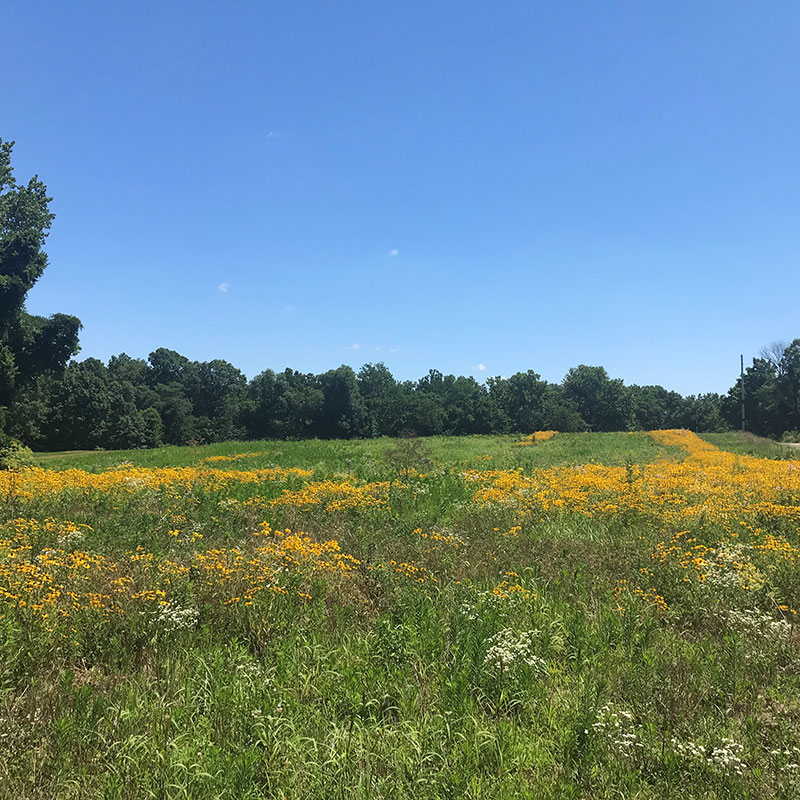
Parke County planting is alive with summer color three years after planting.

- Benton County land acquisition connects pockets of prairie habitat for wildlife
Game Bird Areas were historically focused on providing habitat for ring-necked pheasants. Over time, DNR has recognized the benefits of using a prairie-focused habitat management approach in these areas. Mike Schoof, property manager of Willow Slough Fish & Wildlife Area, uses this approach in the Goose Creek Focal Area. He partnered with the Bicentennial Nature Trust and the National Wild Turkey Federation to add about 450 acres to the Goose Creek Focal Area, a once-isolated space with a valuable stream system. By acquiring more public land in the focal area and connecting it to other spaces, Schoof helps species such as Franklin’s ground squirrel and Kirtland’s snake move more freely and expand their populations. Not only does encouraging quality native habitat around the streams support the species that inhabit the land, but it also improves the water quality for Goose Creek and Mud Pine Creek, as well as for people who live nearby.
Schoof takes pride in seeing the wildlife’s response to his management, and he loves the challenge of working in the Corn Belt. In addition to working toward habitat restoration, Schoof also focuses on cultivating relationships with property owners to conserve their land into the future. “(I’m) focused on … the impact the sale of their land will make to conservation and the memories people can make,” Schoof says. “You have to build core relationships with people.”
To learn more about the Goose Creek Focal Area, contact Willow Slough FWA.
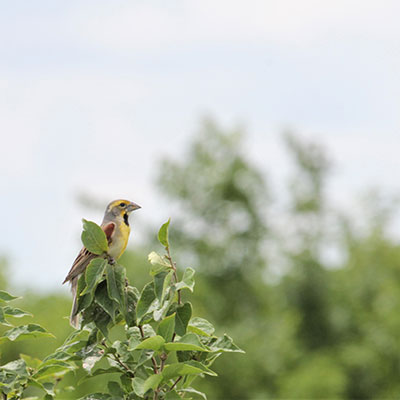
A dickcissel thrives in grasslands.
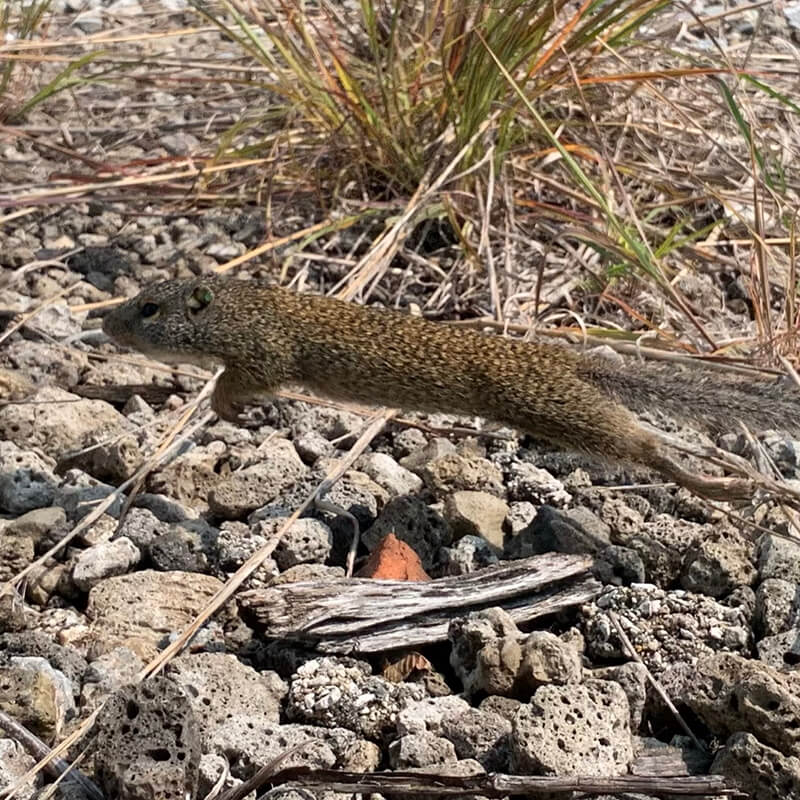
Franklin’s ground squirrel benefits from larger grassland spaces.

- From golf course to wildlife habitat: Private landowners choose conservation
In Bartholomew County, landowners maintained their own private nine-hole golf course on their 70-acre farm. With conservation on their mind, they decided to convert their land into a space that could foster wildlife, with the help of Shannon Winks, a Division of Fish & Wildlife wildlife biologist. Together with the Natural Resources Conservation Service’s Environmental Quality Incentive Program, U.S. Fish and Wildlife Service Partners for Wildlife, and the Farm Service Agency’s Conservation Reserve Program, they transformed the entire farm into spaces for wildlife, converting the acreage into pollinator plantings, warm-season grasses, trees, and shrubs.
The landowners not only reconstructed their own space for conservation, but also opened their property to conduct prescribed-burn workshops and property field days for the public. Winks visits the property as needed to provide guidance on maintaining the habitat. She appreciates how people in the Corn Belt are tied to the land, as it creates opportunities to work together. “The quality of the habitat on the ground is a result of the dedication of the landowner,” Winks says. “Some landowners become like family. We spend a lot of time working toward the shared goal.”
Learn more about Landowner and Wildlife Habitat Assistance.
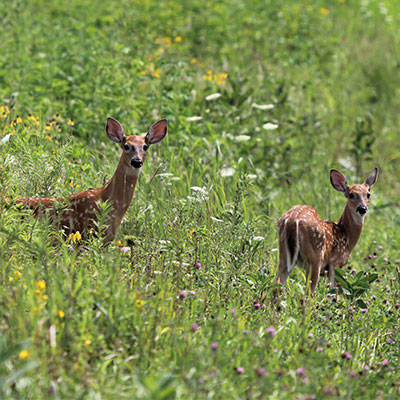
Two white-tailed deer thrive in high-quality wild space.
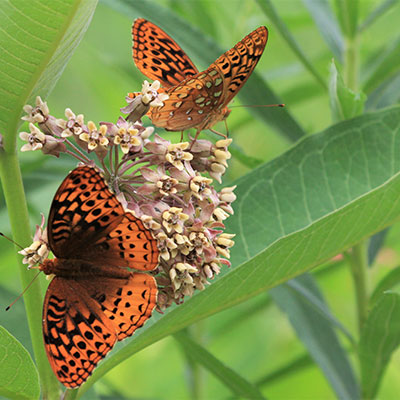
A great spangled fritillary feeds on common milkweed.

Additional Resources
- Want to learn more about other fish and wildlife that live in Indiana?
- Read about this region in the Indiana State Wildlife Action Plan.
